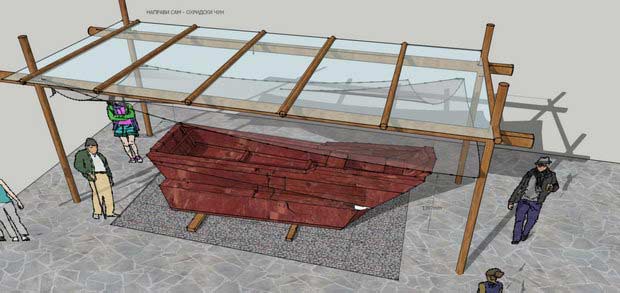IIn the Middle Ages, the development of Art, particularly fresco and icon painting, took place in the same time as the development of the guilds, especially the artistic guilds. The numerous exhibits that can be found in the Ohrid churches as well as in the homes of the respectable Ohrid families testify that.
Fishing is one of the oldest economic businesses. It is also one of the oldest guilds closely connected with the existence of the habitants of the Ohrid region. The people of Ohrid, especially those living in Pestani and Trpejca, have been involved in the fishing business since early times.
From documents of earlier times we can find out that in 1337 the Serbian Czar Dusan awarded one of the catchment areas of Lake Ohrid to the monastery Treskavec (Prilep), and later on to the church Saint Bogorodica Perivlepta (St. Clement). Some travelers, who passed through Ohrid in the XV century, noticed that great quantities of fish were obtained from Lake Ohrid, whilst the fish itself was famous even in Constantinople.
During the Turkish rule of the Balkan, the custom of leasing catchment areas continued. At first, only the Turks were allowed to rent them, but afterwards the Macedonians became leaseholders. Usually they were two or four-year leases.
Towards the XIX century, the livelihood of about 80 families from Ohrid depended on fishing, while for the habitants of Pestani and Trpejca, fishing was the basic activity. Fishing took place throughout the whole year. Evidently, they used to fish trout in winter, spring and summer. Carp was caught in spring, same as the chubb and the skobal, whereas the letnica, in autumn. Grunec and plasica were caught in late autumn and in winter. The fishermen had special fishing equipment that was hand made in the initial period. There were women whose profession was making fishing nets.
The fishing boat was also a feature of this period.
The Ohrid fishing boat was mentioned more than three hundred years ago. Certainly, it was the most interesting type of vessel of the Balkans. Usually, it was made out of beech or fir. It was 4-6 meters long, 1.40-1.60 meters wide, while the rear part of the boat was even wider. The boat was set into motion by three people rowing at the front and two people rowing at the rear. Besides fishing, the boat was used for transportation of goods and passengers. When used in solemn events, the so-called wooden “chardak” was built onto it, with a fence of about half a meter tall. Evidently, the first motor boat in Ohrid was brought in 1912. It was used for military purposes. The old fashioned boat that was not used anymore was quite secure. It is said that fishermen used to sail the lake with their boat even when the waves were over 4 or 5 meters tall.
In the past, apart from the fishing industry, other guilds were also developed such as: coffin-makers, leather processors, cauldron makers, saddle makers, goldsmiths, tailors, shoemakers, and wood-carvers. From the enormous number of woodcarvings in Ohrid, but also throughout the World, one can conclude that this, above all artistic, guild had been developed a long time ago. The oldest work ever found on the territory of Ohrid is the wooden sculpture of Saint Clement of Ohrid that originates from the XIII century. Somewhat older is the famous door of the church Saint Nicolas Bolnicki, originating from the end of the XII century, or the beginning of the XIII century, that in 1916 was taken away to Bulgaria.
In the period that followed, iconostasis were made in the churches Saint Vraci Mali, Saint Constantine and Elena, Saint Naum, Saint Bogorodica Bolnicka, Saint Nikola Gerokomija, Saint Bogorodica Kamensko, and in Saint Bogorodica Perivlepta (Saint Clement). The Czar’s gates of the churches Saint Bogorodica Perivlepta (Saint Clement), Saint Vraci Mal and Saint Vraci Golemi are important woodcarvings.
Towards the end of the past century and the beginning of this one woodcarving has been in its decline. In order to keep up the tradition, in 1925 a school for artistic woodcarving was opened in Debar. In two years time, due to the better working conditions, the school was moved in Ohrid. 48 students enrolled in the first school year. After the end of the Second World War (1947), the school opened again and it had a few departments. In 1949 the school was closed down, however the Woodcarving department was incorporated within the School for Applied Art in Skopje. Masters of the craft were: S. Krstance, P. Kalajdi, K. Janko, N. Donev, A. Veljanov, P. Spirkovski, L. Jambazov, C. Nikoloski and others.
Today only a few enthusiasts follow the woodcarving tradition, but there is also a woodcarving department within the factory EMO.

Virtual Macedonia
Republic of Macedonia Home Page
Here at Virtual Macedonia, we love everything about our country, Republic of Macedonia. We focus on topics relating to travel to Macedonia, Macedonian history, Macedonian Language, Macedonian Culture. Our goal is to help people learn more about the "Jewel of the Balkans- Macedonia" - See more at our About Us page.
Leave a comment || Signup for email || Facebook |
History || Culture || Travel || Politics


















